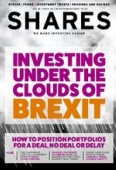Archived article
Please note that tax, investment, pension and ISA rules can change and the information and any views contained in this article may now be inaccurate.
Why are so many CEOs stepping down?

American football may not be everyone’s cup of tea but no less a figure than former Manchester United manager Alex Ferguson drew inspiration from a biography of the legendary Green Bay Packers coach Vince Lombardi.
He shaped a small club in Wisconsin into the National Football League’s dominant force, winning the first two Super Bowl championship games in the early 1960s, and leaving behind him both a sporting legacy and a rich trove of inspirational quotes.
One gem from Lombardi was ‘Winners never quit and quitters never win’. With that in mind, this column is intrigued to see how the number of chief executives (CEOs) leaving their post is running at a relatively high level among the elite ranks of the FTSE 100 in the UK and at record levels in the US.
This is not to say that all of those individuals have just thrown in the towel. But it is intriguing to see changes in the boardroom running at, or above, levels previously only seen during much tougher times for the economies and stock markets of the UK and US.
Should investors therefore be taking the hint that those individuals with perhaps the best insight into their charges’ fortunes are bailing out now, while the going could still be seen as good?
FTSE’S TWELVE
When Kingfisher (KGF) boss Véronique Laury stepped down on 25 September she became the tenth FTSE 100 CEO to do so this year.
Two more changes, at Royal Bank of Scotland (RBS) and then Ferguson (FERG), will become effective before the year end and three more bosses are already preparing to step down in 2020, in what Auto Trader (AUTO), Land Securities (LAND) and Centrica (CNA) are hoping will be smooth transitions.
This year’s tally of a dozen CEO changes with three more announced compares to a post-2000 average of 12 changes a year.
But it is not just in the UK where changes at the top are coming quickly. Research from recruitment specialist Challenger, Gray & Christmas finds that America has just seen the highest number of CEO departures in any individual month in 17 years.
BOARDROOM SHUFFLE
According to the latest monthly data from the Chicago-headquartered firm, 159 US CEOs stepped down in August 2019, a monthly record.
That takes the total number of changes in boss Stateside to 1,009 year-to-date, 15% higher than a year ago and the highest total for the first eight months of the year since Challenger, Gray & Christmas began to keep records in 2002.
This puts the US on track to exceed the number of CEO departures seen in 2008, when many bosses took the chance to head for the hills when they could.
The question that investors must now address is whether the pace of CEO change is telling them something about the global economy and corporate profits.
ALL CHANGE
There are several reasons why a CEO should go, voluntarily or otherwise:
Share price performance has been poor, something has gone wrong or both and investors or the board felt it was time for a change. The rise of activist investing continues to increase the pressure on CEOs to deliver
Companies where perhaps investors felt it was time for a change or the executive in question felt ready for a fresh challenge or a break
There may be instances where the executive feels now is a good time to go, to ensure their legacy looks like a good one
With this latter point in mind, the more cynically-minded may wonder whether some American executives are getting out while the going is still good, and their share options are looking promising, as the benchmark S&P 500 index reaches for the 3,000 mark once more.
After all, the previous peak in CEO changes, according to Challenger, Gray & Christmas’ American data, came in 2008, just before the wheels fell off the global economy and stock market alike.
It is possible to counter such dark thoughts. August’s US CEO departure rate of 159 is just 3% higher than August 2018 and the rate of growth in changes of leader has slowed markedly over the past 12 months.
It can be argued that economic data is starting to stabilise in the US, after a sticky patch. Bulls will assert that the worst could be over; especially if Washington and Beijing can reach a trade accord and central banks can keep growth going with a fresh round of interest rate cuts. Any drop in the pace of boardroom changes could be seen as a sign of gathering optimism about the future.
Important information:
These articles are provided by Shares magazine which is published by AJ Bell Media, a part of AJ Bell. Shares is not written by AJ Bell.
Shares is provided for your general information and use and is not a personal recommendation to invest. It is not intended to be relied upon by you in making or not making any investment decisions. The investments referred to in these articles will not be suitable for all investors. If in doubt please seek appropriate independent financial advice.
Investors acting on the information in these articles do so at their own risk and AJ Bell Media and its staff do not accept liability for losses suffered by investors as a result of their investment decisions.

 magazine
magazine












